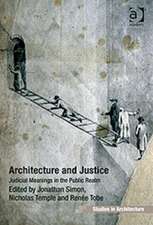Architecture as a Performing Art
Editat de Marcia Feuerstein, Gray Readen Limba Engleză Hardback – 27 mar 2013
Preț: 851.40 lei
Preț vechi: 1142.61 lei
-25% Nou
Puncte Express: 1277
Preț estimativ în valută:
162.94€ • 168.32$ • 135.60£
162.94€ • 168.32$ • 135.60£
Carte tipărită la comandă
Livrare economică 26 martie-09 aprilie
Preluare comenzi: 021 569.72.76
Specificații
ISBN-13: 9781409442356
ISBN-10: 1409442357
Pagini: 248
Dimensiuni: 174 x 246 x 21 mm
Greutate: 0.66 kg
Ediția:New.
Editura: Taylor & Francis
Colecția Routledge
Locul publicării:Oxford, United Kingdom
ISBN-10: 1409442357
Pagini: 248
Dimensiuni: 174 x 246 x 21 mm
Greutate: 0.66 kg
Ediția:New.
Editura: Taylor & Francis
Colecția Routledge
Locul publicării:Oxford, United Kingdom
Cuprins
Introduction: The Play’s the Thing, Gray Read; Part 1 Designing Performance; Chapter 1 Architecture as a Performing Art: Two Analogical Reflections, Alberto P?rez-Gómez; Chapter 2 Performing The?ria: Architectural Acts in Aristophanes’ Peace, Lisa Landrum; Chapter 3 Toward Performative Architectural Drawing: Paul Klee’s Enacted Lines, Paul Emmons, Carolina Dayer; Chapter 4 Performing the Modernist Dwelling: The Unité d’Habitation of Marseille, Sarah Bonnemaison; Chapter 5 Staging: Making a Scene, Peter P. Goché; Chapter 6 Salvaged Layers: A Collaborative Site-Specific Performance, Timothy Gray, Melli Hoppe; Part 2 Performing Design; Chapter 7 Through the Lens: Image and Illusion at Play in the Ideal City, Ann Marie Borys; Chapter 8 The Satyric Scene: Palladio’s Villa Rotonda, Tracey Eve Winton; Chapter 9 Performing Architecture: From Medieval Festival to Modern-Day Carnival, Louise Pelletier; Chapter 10, Christine Macy; Chapter 11 Turned Tables: The Public as Performers in Jean Nouvel’s Pre-performance Spaces, Beth Weinstein; Chapter 12 Theatrical Doubles: The Affecting Presence of Oskar Schlemmer’s Wall Designs, Marcia Feuerstein; Chapter 13 Paideia: Theater of Discussion, Gray Read;
Descriere
This collection of essays reveals a deep alliance between architecture and the performing arts, uncovering its roots in ancient stories, and tracing a continuous tradition of thought that emerges in contemporary practice. With fresh insight, the authors ask how buildings perform with people as partners, rather than how they look as formal compositions. It advances architectural theory, history, and criticism by proposing the lens of performance as a way to engage the multiple roles that buildings can play, without reducing them to functional categories.











